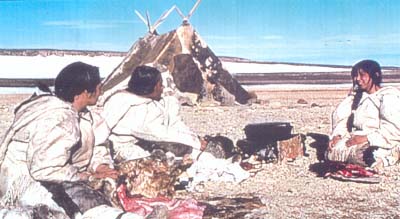REVIEW by Willard Manus
THE FAST RUNNER could
almost be called "The First Runner," if only because it's the
first feature film about the Inuits to make it to the screen. Not only
that, it features an all-Inuit cast and was written, directed and produced
mostly by Inuits as well. Funded by the Canadian government and the Aboriginal
Peoples Television Network, THE FAST RUNNER (ATANARJUAT) was shot over
a six-month period on the island of Igloolik, a small island in the north
Baffin region of the Canadian Artic with archaeological evidence of 4,000
years of continuous habitation. The history, culture and rituals of the
nomadic people residing here are emphasized in the script by Paul Apak
Angilirq, with the bleak landscape of the Arctic playing an equally important
role. Inuit language is used throughout, with English subtitles for comprehension.

Set in the early 1800s, before the Inuits encountered the first Europeans
to penetrate their remote society, THE FAST RUNNER also features authentic
costumes, props and sets, drawing on both Inuit oral history and traditional
knowledge, and the 1822-23 journals of Admiral Perry for precise details.
The set designers and seamstresses had to re-learn ancient skills to make
the hunting implements, household objects and dogsleds from bone, stone,
antler and ivory, and kayaks, tents and costumes from animal skins.
Angilirq also uses age-old Inuit myth and fable to underpin his sweeping,
2 1/2 hour tale of two clans jousting with each other under northern skies.
For
all its historical truth, this is not a sanitized, National Geographic-like
take on aboriginal people. THE FAST RUNNER is replete with violence, blood,
sex, rape, dirty jokes, belching and pissing. In short, it's an all-too
human document, one to which we can all relate.
The force that pits one clan against another is attributed to an unknown
shaman--read, evil force--that visits the small community of Inuits but
doesn't manifest itself until twenty years later, when an arrogant young
man named Oki (Peter-Henry Arnatsiaq) swears vengeance on Atanarjuat (Nator
Ungalaaq, a successful sculptor in real life) for taking his girlfriend
Puja (Lucy Tulugarjuk) away from him.
Puja is the one who is possessed by evil, which accounts for her selfish,
flirtatious ways; one old woman even calls her a witch. At the same time,
she is also sweet, sexy and playful, not at all like the typical bad girl
in a Hollywood film about satanic-possession who would, at some point,
grow fangs and breathe noxious fumes.
Her sin was to have set personal desire above the needs of the group.
Even though it leads to violence and retribution, she and Oki can be forgiven,
as long as they renounce their mistakes and beg to be accepted once again
by their families. In the harsh, unforgiving Arctic, the Inuits' survival
depended on
cooperation and harmony, everyone pulling together as a team--like the
dogs who powered their sleds. Director Zacharias Kunuk and cameraman Norman
Cohn do a remarkable job of bringing this point home. Working under the
most difficult conditions imaginable, they lived in igloos and stone huts
all during the long shoot, braving winter and spring storms to get the
footage they needed, surviving on the meat and fish caught by Inuit hunters.
THE FAST RUNNER was shot on wide screen (16.9) digital betacam, later
transferred to 35mm. By using digital, Cohn was able to go places a film
camera never could. The result is a movie that pulls you right inside
the action, making you feel you are part of life as it was lived by the
Inuits two hundred years ago.